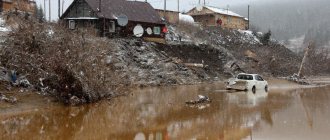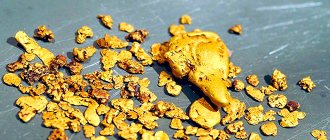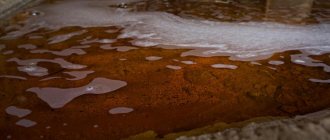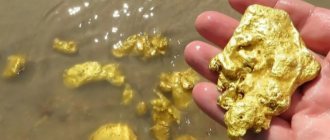Where it all began
The Krasnoyarsk Territory has been a leader in gold mining in Russia for many years, being one of the oldest gold-mining regions. Since the first half of the 19th century, when Yenisei gold accounted for almost half of world production, it was the main supplier of gold in Russia. By the way, it was thanks to this that, back in 1851, a lion appeared on the coat of arms of Krasnoyarsk, in one paw there was a sickle, symbolizing peasant labor, and in the other, a shovel, the main tool of gold miners.
Gold washing machine on one of the tributaries of the Upper Tunguska
Source: www.vokrugsveta.ru
However, it all began a little earlier - in 1828, when the Kuznetsov merchants received permission to mine gold in Siberia and began to hire workers who worked both in the mines themselves and in the owner’s gold pans. Over the next 20 years, the territory where placers were found grew several times, and the heyday of gold mining occurred in the mid-40s, when a total of 120 mines produced more than 20 tons of metal - 90% of the total gold mining in Russia.
In general, approximately 25-30 thousand workers were working in the gold industry at that time, and most of them were exiled settlers - in those days only those who had reached the social bottom worked here. The work process was tedious, but did not require much intelligence - gold was mined and washed by hand, using a pickaxe, crowbar and shovel. The rock was transported in simple wooden wheelbarrows, which had the misfortune of overturning at the most inopportune times, and the gold was washed in ice water using primitive iron sieves - butars. Despite such inconveniences, due to the fact that labor cost a penny and there was no competition, businessmen were in no hurry to mechanize the process.
Over the next 15 years, every ruble invested in production paid off many times over (the profits of some industrialists reached 400%), but by the beginning of the 60s, gold mining in the Yenisei province fell sharply due to the fact that all the rich placers had already been worked out by that time, and the epicenter The gold rush gradually moved to the Lena River basin.
Reaction from abroad
In the 19th century, the huge amount of metal being mined could not go unnoticed. Foreign geologists showed interest in some regions of Russia, namely Siberia, trying to study it in order to look for territories with gold that would be similar in geological and geomorphological properties to the area being studied.
The search was successful. A large deposit was discovered. The center of the deposit is California, America. Deposits were discovered in the 19th century, after which the “gold rush” began there.
Gavrila served as a prospector, Gavrila looked for gold
It’s no secret that precious metal can turn anyone’s head, but during the gold rush in Siberia there was one industrialist who especially distinguished himself in this regard - Gavrila Masharov, who was incredibly lucky in his search for gold. Compared to him, the merchant Nikita Myasnikov, who made gold business cards that cost as much as a bucket of black caviar, seemed like a baby, because in those days when most workers had difficulty earning enough bread, Gavrila sent his work pants to Parisian laundries, and also cast himself the famous 10- a kilogram medal with the inscription: “Gavrila Masharov - Emperor of the entire taiga.”
It would seem that it is difficult to imagine a more ridiculous quirk, but the industrialist, whom people called only “the taiga Napoleon,” decided to go even further - he wanted to build a palace for his beloved, as well as a temple, a school and a factory, so that later an entire city would grow in the taiga . However, the role of a city-forming enterprise was difficult for Masharov - despite the fact that Gavrila was a hardworking, persistent and very lucky person, he got into huge debts because of his palace.
Soon the competitors, who just yesterday had willingly lent money to realize Gavrila’s bold fantasies, demanded that he pay with the mines, and the fisherman himself was locked in his own palace, promising to be released only after he signed his placers to the creditors. Realizing that his whim was backfiring, Gavrila tried to dig under and get out, but the house was built to last, and Masharov, unable to get to the bottom edge of the foundation, gave up this idea. Three days later, lucky in gold mining, but unlucky in life, Gavrila was found dead, and in the hole he dug, they came across gold, which turned out to be part of a large vein that passed under Masharov’s house and stretched for more than 10 kilometers. It turns out that Napoleon of the taiga sensed gold even when he started his utopian project with the palace, but at that moment his instincts still failed him.
Decrease in production
In the 19th century, production rates in Eastern Siberia decreased, and this is easy to explain. The mined metal did not stay in the industry; they were in a hurry to sell it in order to invest it in trade or shipping.
These actions led to negative consequences - by the twenties, the mining of the precious metal in Siberia had practically stopped, and soon private enterprises were completely closed.
The decline in production can be explained by another reason - the lack of qualified specialists. To correct this, a training center was created and a competent program was formed. Then, in 1892, a practical training course was created for students of the Industrial School, that is, they were sent to the territories of the Olikem and Vitim systems, where mining is carried out.
A permit was required, which was issued to Governor General A.D. Goremykin. A small group of 8th grade students was sent to the mines. This was done to become familiar with the technique and all the intricacies of the work.
The information received was useful - the students were able to write essay reports. This is how future personnel were prepared.
Invisible gold, a disappeared city and friendship with bears. How they live in the gold mines of Transbaikalia
Photo: Askhad Bzegezhev
Seven tired miners
Six hours by plane from Moscow to Chita and two hours by helicopter or eight hours by jeep along the Trans-Baikal off-road - this is exactly the route you will have to take to get from the capital to the Mangazeya gold deposits.
The company mines gold at three deposits: Savkino, Nasedkino and Kochkovskoye. There is a small village near the Savkinskoye deposit. Almost 800 company employees live here. Every morning, some of the miners go to the quarry, where excavators and BelAZ trucks work around the clock. People usually get to the field by car or by bus. Between the village and the place of work there is a sparse forest and a winding dirt road.
Sergei Klimenko, managing director, calls the workers' village a place of power. Sergei talks about how he himself began his career as a gold miner:
“When I was 20 years old, I went as an intern to a placer gold site. For two days I wandered with six other miners in knee-deep water, passing rock through a tray and washing it. When you do this two days in a row, your back starts to fall off, your head hurts, your arms hurt, everything hurts. We didn't find anything. Generally zero. And so the six of us are sitting, thinking: “What kind of gold? He’s not here, we’ve all been deceived.” And the seventh continues to search. We were exhausted in the sun, we wanted to sleep, but then we heard the cry: “Found, found!” All of us who were sitting on the shore rushed into the water: there the seventh one was holding a grain of sand, a piece of gold in his hands. Now I would just throw it away. And then we started an argument for fun. They dug a hole twenty by twenty centimeters, it immediately filled with water. We threw our gold coin there and began to search for speed. After 20 minutes it was already a hole two by two meters and half a meter deep. We never found the gold coin.”
Paradoxically, mining the precious metal using technology and a customized conveyor is in some ways harder than searching for gold by hand. If gold flecks can be seen with the naked eye, then the ore gold, which Transbaikalia is so rich in, cannot be detected in the form of gold pebbles. However, some experts can still figure out where to look for “invisible gold.”
How to mine invisible gold
Photo: Askhad Bzegezhev
There are two types of gold: placer and ore. Placer is just that which can be found in the form of gold flakes or larger nuggets. It is very difficult to see ore before processing. To obtain gold bars, the ore is crushed into pieces up to 10 millimeters in size, then the gold is separated from the rock-forming materials.
But before you start mining ore, you need to understand whether it actually contains gold. To do this, geologists conduct exploration, without which the company may suffer huge losses. But the matter does not end with reconnaissance. The geologist studies the ore even at the stage when the blasted pieces of rock are already delivered to the crusher.
Nadya, a young geologist, stands on a small hill from 8:00 to 20:00 and controls the process of preparing ore for shipment. Its task is to determine which pieces of rock contain gold and which do not. As Nadya says, ore gold only seems invisible, and in fact, you can understand whether it is there or not, including by the color of the stones:
“We don’t need these gray pebbles, but the red ones are exactly what we are looking for. I have to visualize the oxidized ore so that it is gold that goes into processing, not waste rock.”
According to Nadya, there are a lot of women working on her site, although in general this is rare for the geologist profession. But the workers don’t call each other “geologists”, they are just geologists.
The founder and owner of the group, Sergei Yanchukov, says: “Gold mining is a technologically complex production that requires large investments and long-term solutions. From obtaining a license to commissioning it can take five to eight years, or even more. The investor takes on serious risks associated with gold reserves, ore enrichment technologies and the complexity of their composition - all this can be different even at one deposit. It is possible to minimize risks - this is the professionalism of the company’s geological exploration.”
Photo: Askhad Bzegezhev
After the crusher, gold-bearing stones are treated with a special solution that passes through the ore and absorbs the gold. This gold-bearing solution is then processed in a beneficiation plant. This is where finished gold bars are obtained.
How do they live in a workers' village?
Photo: Askhad Bzegezhev
While I’m on my way to the processing plant to finally touch gold with my own hands, small villages with several crumbling houses appear a couple of times in the desert landscape outside the windows of the jeep. Riding in the car with me is Gulnara, a 40-45 year old woman, the head of the administrative maintenance department in a workers’ village. Together we watch two village boys sledding on dry soil. Among the small houses, a five-story building suddenly appears - an ordinary Khrushchev block in the middle of a dark orange desert. Gulnara says that this is a five-story building with stove heating. Although conditions in the workers' settlement are much better than in nearby villages, this place is still far from civilization.
— What do workers do in their free time? — I ask Gulnara.
— We built a volleyball field and installed table tennis so that we could play sports. Sometimes we find something interesting, the nature is unusual. Recently a moonstone was found.
Photo: Askhad Bzegezhev
The stone was named so because of its numerous dents, similar to lunar craters. Workers sometimes go to the moonstone as a local landmark, take photographs and send them to their relatives. Behind the stone the forest begins. According to the rules, you can’t go there - bears might attack. At the same time, the bears may not wait in the forest, but show up to the workers themselves: once a mother bear and three cubs found food waste near the enterprise and came for dinner at the same time for several days.
“Mangazeya” received its name in honor of the polar Siberian city of the 17th century. Mangazeya was called “boiling gold”, legends were made about its riches, but these stories, as well as several historical artifacts, are the only thing that remains of the “ghost town”.
At the factory
At all three deposits, company employees told me that gold in its usual jewelry form would most likely not be seen, because a limited number of people have access to safes with processed gold. The safes are located in the gold reception desk at the processing plant. Access to them is possible only with the permission of the enterprise security service.
After negotiations, I was finally allowed to look at the gold. Gulnara asked to join me - in her many years of work in the fields, she had also never seen mined precious metal. The head of the security service took out a handful of gold stones and allowed them to be photographed.
Photo: Askhad Bzegezhev
Laboratory employees said that Mangazeya processes 82 thousand tons of ore per month. A labor-intensive process with quarries, excavators, crushers, explosions ends in a quiet room with several safes. And it turned out that people working in gold mining are interested not so much in gold as the final product, but in the mining process itself and life in the deposits of Eastern Siberia. Sergei came here in search of something new, Gulnara has been working on shifts for 16 years, and she enjoys it, Nadya likes to call the western quarry the “Wild West” and carry out blasting operations there. According to the founder of Mangazeya, Sergei Yanchukov, up to 90% of the personnel at the fields are local residents, but there are also those who come to work on shift from villages 500-1000 km away. Here, in Transbaikalia, as the workers themselves say, they find the meaning of life, and gold is just a by-product.
Real situation
In countries such as South America, Africa, Asia, a huge number of people are saved by extracting gold using the artisanal method. It is easier to mine in areas where the source of the precious metal is volcanic activity, because in this case the gold is located shallow from the surface of the earth.
It is possible to identify areas that relate to this:
- Far East (Khakanja);
- Aldan (Kuranahanskoe);
- Rudny Altai;
- Olkhovka;
- Chibizhek.
In these areas, more than 10 million people are engaged in this type of activity. Extraction is carried out manually, which saves on industrial-scale development.
That is why alluvial deposits were a priority, and indigenous ones were not popular.
There are countries where artisanal mining is prohibited, including Russia. Article 191 of the Criminal Code states that those who engage in this type of activity can be imprisoned for up to 7 years and receive a huge fine. Because of this, the percentage of unemployed in the regions of Siberia and the Far East has rapidly increased. This may have consequences – an outflow of citizens to more developed regions.
The precautions taken did not contribute to the complete disappearance of illegal immigrants. It is unknown how many of them work in various taiga mines. But there is information that the Krasnoyarsk Territory annually supplies 1-2 tons of gold mined illegally. Therefore, criminals are regularly detained. To have the right to carry out work, you need to buy a license from gold mining organizations.
There are countries where searching for valuable metal is allowed. These include America, Canada and Australia. A license for this type of activity is inexpensive, only $30. People can purchase a metal detector and calmly search for the metal of interest.
In this regard, tourism is actively developing, the purpose of which is gold mining.
Legalization
In Russia they want to legalize gold mining, because then illegal immigrants will cease to exist. Industrial mining is no longer possible in many areas, which is another reason to legalize this area of activity.
Nicholas II was loyal to gold miners - in 1902 he allowed this activity to be carried out freely. Stalin did not change anything in this order of things, which was a significant plus for the economy of the entire Soviet Union. The government provided good conditions for the activities of workers and even organized holidays for them in sanatoriums and resorts.
But not everyone could do this: those who had ever been prosecuted could not obtain permission to carry out this type of activity.
As a result, 120 thousand people became miners, they sold gold to special cash desks. Thanks to them, many deposits were discovered, which were subsequently monopolized by state-owned enterprises. Therefore, from 1932 to 1941 the volume of production increased significantly (5 times).
A ban on mining was introduced already in 1950.
How gold was mined before
But in the 19th century, more interesting methods of extracting precious metals were used. Many useful inventions were created. One of the first is a machine for golden sands. The innovative technique was invented by the merchant Pakulev. He received a good reward in the form of a mining “privilege” for 10 years from the then government, this happened on May 2, 1875.
In 1875, another interesting invention appeared - a machine for opening rock. Testing was successful in 1858. But subsequent tests were failures, the device was later forgotten, and its drawings were lost.
A grandiose invention – the “sand truck”. The machine was created by A. N. Lopatin in 1859. In 1860, the machine was modernized and successfully operated in Eastern Siberia.
Water lifting technology was created in 1860. Unfortunately, nothing is known about its creator. The machine was first used at the Olekminsky mines, and in 1914 at the Nizhny, Lenzoloto and Fedoseevsky mines.
There are special ships called “drags” that go through the bottom of the river, helping to extract gold. In areas located near Spassk and on Usa, this type of activity is still practiced to this day.
Alaskan Gold Rush
Alaska was part of Tsarist Russia until 1867, when the United States bought it for just seven million dollars that year. Russian engineer Doroshin reported to the Tsarist government as early as 1848 that he had discovered pieces of gold in Cook Inlet during his exploration voyages in Alaska, but that their occurrence was not widespread enough to warrant regular mining there. Gold was found and the gold rush began in 1896 by explorers George Washington Carmack and Robert Henderson on the Tron Duc River.
The Alaska Gold Rush brought about 78 tons of gold, and was reflected in the stories and novels of Jack London. Between 1801 and 1900, 3,589 tons of gold were mined in the United States (including Alaska).
Methods
Gold can be mined in several ways: sand washing, metal extraction in mines. At the moment, artisanal gold mining is popular. This means that the chosen places are already known, and gold was mined in them on an industrial scale, and the seekers are collecting the remains. This is labor-intensive and difficult work.
Manual panning for gold is one of the most ancient and popular methods of gold mining. During the rains, gold falls into the river; it is during such periods that miners tend to work.
A more complex method is digging. First, the metal must be dug out and then washed. Unnecessary components are crushed, washed again, and then the gold particles are independently selected.
After the desired metal has been obtained, it must be extracted from the ore. There are several ways in which this can be done.
An interesting method is mercury amalgamation. In this case, sand is amalgaated in the presence of gold particles having a size of no more than 1 mm. It is necessary to dissolve the resulting metal in a substance (mercury), as a result of which an amalgam is formed. Next, you need to strain the substance through a fine-mesh cloth. Half of the substance is gold. To obtain it, you need to evaporate the mercury.
Cyanidation and flotation involve three stages of action:
- leaching;
- concentration;
- cleaning
Cyanide and oxygen promote the leaching process. The concentrate of heavy minerals is removed through activated carbon, filtration and calcination. There is a disadvantage to this method - a high level of danger. It is caused by cyanide vapors.
Chlorination occurs using hydrochloric acid and chlorine. They can dissolve gold. The next step is to rid the metal of heavy minerals and form an ingot.
All these methods have a negative impact on the environment, because there is waste that needs to be disposed of.
Investments
Now many scientists are concerned about searching for new gold deposits. Some say that in 50 years the existing reserves will be depleted. Therefore, leaching is the way of the future.
There is one unexplored resource - the ocean. Sea deposits are a common occurrence. One can only guess what lies beneath the ocean floor. Some suggest that incredibly large reserves of gold may be found there.
Recently, the ruble exchange rate has fallen against the dollar and euro. It is for this reason that it is profitable to invest in gold. Many citizens invest in the gold mining industry. Of course, the Federal District of Siberia, the territories of Altai and Kuzbass are attractive. In 2015, local authorities opened auctions for the purchase of rights to own and exploit territories with precious metals.
Many plots lie on Kuzbass land. In addition to gold, there is also coal, it is called black gold. Unconfirmed sources say that there are deposits there with 500 tons of precious metal. That is, there is a prospect.
In Altai, not only gold is mined, but also silver and copper. It has been extracted in this area since the 18th century. The potential here is good. After the arrival of Soviet power, activities were suspended and resumed in the 80s. In 1995, about 135 kg were extracted in the region. Now the situation has improved significantly. The Topolinskoye deposit is promising. It has an area of 96 square meters and is believed to contain 50 tons of precious metal. The search for new deposits is underway.
New and existing deposits in Siberia are the foundation of the gold mining industry of the Russian Federation. Encouraging results from research into new gold mining sites in this area regularly appear. The process will not stop as long as there is something to extract. Fortunately, resources are plentiful: there are many other minerals besides gold.










